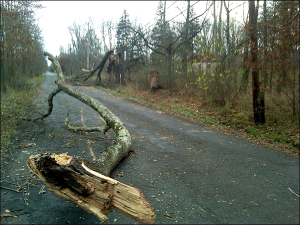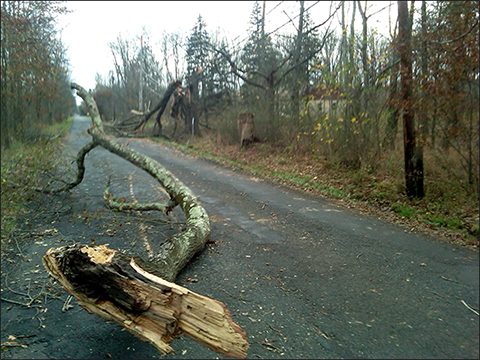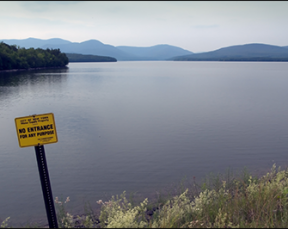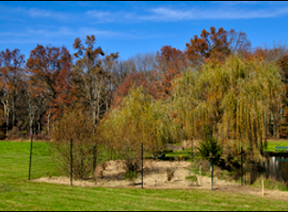It has been more than a year and one-half since the wind and rain of Hurricane Sandy pounded our area of New Jersey. Many residents along the Jersey Shore continue working hard to restore their houses and businesses, badly damaged by the storm.


Trees downed by Hurricane Sandy line a road through New Jersey’s Great Swamp. Credit: Dave Sagan/USFWS
For most of us in the area of the Great Swamp, it was all about trees — they fell in troubling places, such as on the roofs of houses, across roads, or just stretched across the ground in some untidy fashion. We are practical folks, so our immediate focus was to fix the roof, open the road, or otherwise clean up after the fallen trees. For most of us, what’s the matter with the loss of a few trees here or there, as long as our property is secure? Many of us were focused just on the short-term cost of the cleanup. Let me suggest that we should also consider the cumulative effect that Hurricane Sandy had on our trees. Let’s also look at the some important longer-term actions that will benefit us by benefitting our trees.
Forests have supported the existence of humans since we first appeared — some say that trees and forests are the highest-functioning members of ecological society. They are ecosystem “engineers” that create conditions for other forms of life to exist on every level. The loss of a few trees, our ecological infrastructure, usually isn’t very dramatic overall; it’s a quiet event. But the impacts may be great over time.
Take a minute to imagine if every tree around your home, your town, your state, were to wither and die; or be destroyed by forest fire or wind storm. What would your world be like? Few people are thinking about the future of forests and trees.
In his 2012 book, The Man Who Planted Trees, Jim Robbins says that more than 90% of America’s old-growth forest is gone and is still being cut, and that 80% of the world’s forests have vanished. Yet we have only begun, he says, to understand the ecological role these forests play or what secrets might be locked away in their genes.
So, do we really appreciate how important trees are to us? This beneficial relationship has endured since the dawn of human kind, since our ancestors first climbed into trees to escape predators. Perhaps trees play an unappreciated role in sustaining our lives on the planet.
According to Robbins, trees provide us with some very important services. Here’s a short list of what they accomplish.
- Trees are responsible for half the photosynthesis on land. They take in the energy from sunlight and transform it into leaves, where that energy becomes available for use by insects, mammals, and birds.
- Trees are highly evolved water management specialists. A forest is a soft carpet on the landscape that allows a downpour to reach the ground gently rather than in a torrent. Suitably slowed by trees (and other vegetation), that water can recharge groundwater supplies by being absorbed, instead of being shed as runoff.
- Trees feed oxygen and minerals into the ocean and create rain.
- Trees can render harmless mercury, nitrates, and other toxic wastes in the soil.
- Trees gather and neutralize sulfur dioxide, ozone, carbon dioxide and other harmful pollutants in their tissue.
- Trees create the material for building homes, offer shade, provide medicine, and produce a wide variety of nuts and fruits. In fact, they sustain all manner of wildlife with an array of food and shelter.
- Trees are the planet’s heat shield, slowing the evaporation of water and cooling the earth.
- Trees generate vast clouds of chemicals that are vital to myriad aspects of the earth’s eco-systems, and are vital to human health and well-being.
- Trees are natural reservoirs — as much as a hundred gallons of water may be stored in the crown of a large tree. They release this water into the air as part of a largely unrecognized water cycle.


The Water Cycle. Credit: U.S. Dept. of the Interior. U.S. Geological Survey. John Evans, Howard Perlman, USGS.
Because trees offer their services in silence, and for free, we take them for granted. But some of us don’t. In the Borough of Madison, for example, concerned citizens have spearheaded a special effort to grow young trees that are made available to Madison residents for re-planting, particularly along streets and where they will not interfere with utility wires overhead. Of course, it will take many years for these trees to mature and achieve their full capacity, but now is the time to begin the process. Tree replacement needs to happen early to be fully benefit us. Private citizens in municipalities throughout the Great Swamp region have already made tree replacement a high priority.




